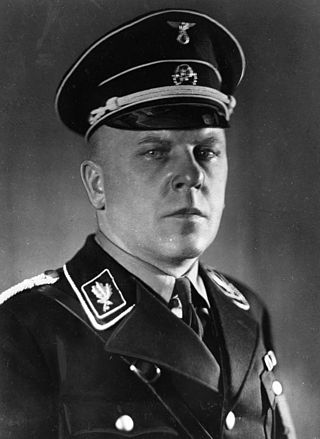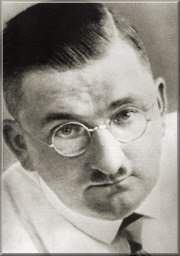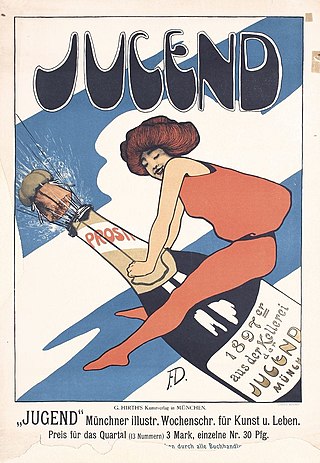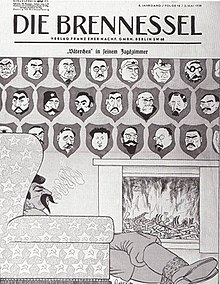
Paul Joseph Goebbels was a German philologist and Nazi politician who was the Gauleiter of Berlin, chief propagandist for the Nazi Party, and then Reich Minister of Propaganda from 1933 to 1945. He was one of Adolf Hitler's closest and most devoted followers, known for his skills in public speaking and his deeply virulent antisemitism which was evident in his publicly voiced views. He advocated progressively harsher discrimination, including the extermination of the Jews in the Holocaust.

Mein Kampf is a 1925 autobiographical manifesto by Nazi Party leader Adolf Hitler. The work describes the process by which Hitler became antisemitic and outlines his political ideology and future plans for Germany. Volume 1 of Mein Kampf was published in 1925 and Volume 2 in 1926. The book was edited first by Emil Maurice, then by Hitler's deputy Rudolf Hess.

Julius Streicher was a member of the Nazi Party, the Gauleiter of Franconia and a member of the Reichstag, the national legislature. He was the founder and publisher of the virulently antisemitic newspaper Der Stürmer, which became a central element of the Nazi propaganda machine. The publishing firm was financially very successful and made Streicher a multi-millionaire.

Der Stürmer was a weekly German tabloid-format newspaper published from 1923 to the end of World War II by Julius Streicher, the Gauleiter of Franconia, with brief suspensions in publication due to legal difficulties. It was a significant part of Nazi propaganda, and was virulently anti-Semitic. The paper was not an official publication of the Nazi Party, but was published privately by Streicher. For this reason, the paper did not display the Nazi Party swastika in its logo.

Max Amann was a high-ranking member of the Nazi Party, a German politician, businessman and art collector, including of looted art. He was the first business manager of the Nazi Party and later became the head of Eher Verlag, the official Nazi Party publishing house. He was also the Reichsleiter for the press. After the war ended, Amann was arrested by U.S. military occupation authorities. A denazification court deemed him a Hauptschuldiger. Amann was sentenced to ten years in a labour camp, stripped of his property, pension rights, and virtually all of his fortune.

The Völkischer Beobachter was the newspaper of the Nazi Party (NSDAP) from 25 December 1920. It first appeared weekly, then daily from 8 February 1923. For twenty-four years it formed part of the official public face of the Nazi Party until its last edition at the end of April 1945. The paper was banned and ceased publication between November 1923, after Adolf Hitler's arrest for leading the unsuccessful Beer Hall Putsch in Munich, and February 1925, the approximate date of the relaunching of the Party.

Stern is an illustrated, broadly left-liberal, weekly current affairs magazine published in Hamburg, Germany, by Gruner + Jahr, a subsidiary of Bertelsmann. Under the editorship (1948–1980) of its founder Henri Nannen, it attained a circulation of between 1.5 and 1.8 million, the largest in Europe's for a magazine of its kind.

The Berliner Tageblatt or BT was a German language newspaper published in Berlin from 1872 to 1939. Along with the Frankfurter Zeitung, it became one of the most important liberal German newspapers of its time.

Carl Albert Fritz Michael Gerlich was a German journalist and historian, and one of the main journalistic resistors of Adolf Hitler. He was arrested, later killed and cremated at the Dachau concentration camp.

Heinrich Hoffmann was Adolf Hitler's official photographer, and a Nazi politician and publisher, who was a member of Hitler's intimate circle. Hoffmann's photographs were a significant part of Hitler's propaganda campaign to present himself and the Nazi Party as a significant mass phenomenon. He received royalties from all uses of Hitler's image, which made him a millionaire over the course of Hitler's rule. After the Second World War he was tried and sentenced to 10 years in prison for war profiteering. He was classified by the Allies' Art Looting Investigators to be a "major offender" in Nazi art plundering of Jews, as both art dealer and collector and his art collection, which contained many artworks looted from Jews, was ordered confiscated by the Allies. Hoffmann's sentence was reduced to 4 years on appeal. In 1956, the Bavarian State ordered all art under its control and formerly possessed by Hoffmann to be returned to him.

Simplicissimus was a satirical German weekly magazine, headquartered in Munich, and founded by Albert Langen in April 1896. It continued publishing until 1967, interrupted by a hiatus from 1944–1954, and became a biweekly in 1964. It took its name from the protagonist of Grimmelshausen's 1668 novel Der Abenteuerliche Simplicissimus Teutsch.

The propaganda used by the German Nazi Party in the years leading up to and during Adolf Hitler's dictatorship of Germany from 1933 to 1945 was a crucial instrument for acquiring and maintaining power, and for the implementation of Nazi policies.
Franz Eher Nachfolger GmbH was the central publishing house of the Nazi Party and one of the largest book and periodical firms during the Nazi Germany. It was acquired by the party on 17 December 1920 for 115,000 Papiermark.

Der Angriff was the official newspaper of the Berlin Gau of the Nazi Party. Founded in 1927, the last edition of the newspaper was published on 24 April 1945.

Leopold Ullstein was the founder and publisher of several successful German newspapers, including B.Z. am Mittag and Berliner Morgenpost. Many of these are still published today. Ullstein was also the founder of the leading German publishing house Ullstein-Verlag.

Kladderadatsch was a satirical German-language magazine first published in Berlin on 7 May 1848. It appeared weekly or as the Kladderadatsch put it: "daily, except for weekdays." It was founded by Albert Hofmann and David Kalisch, the latter the son of a Jewish merchant and the author of several works of comedy. Publication ceased in 1944.

Illustrierter Beobachter was an illustrated propaganda magazine which the German Nazi Party published. It was published from 1926 to 1945 in Munich, and edited by Hermann Esser.

Jugend (1896–1940) was an influential German arts magazine. Founded in Munich by Georg Hirth who edited it until his death in 1916, the weekly was originally intended to showcase German Arts and Crafts, but became famous for showcasing the German version of Art Nouveau instead. It was also famed for its "shockingly brilliant covers and radical editorial tone" and for its avant-garde influence on German arts and culture for decades, ultimately launching the eponymous Jugendstil movement in Munich, Weimar and Germany's Darmstadt Artists' Colony.

The Nazi Party and its ideological allies used cartoons and caricatures as a main pillar in their propaganda campaigns. Such techniques were an effective way to spread their ideology throughout Nazi Germany and beyond. The use of caricatures was a popular method within the party when pursuing their campaign against the United States, in particular its then-President Franklin D. Roosevelt.

















